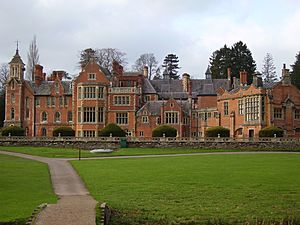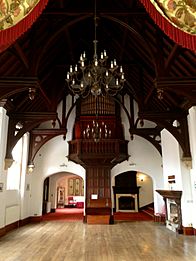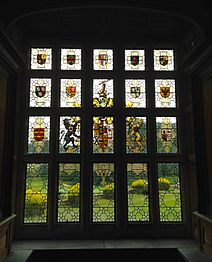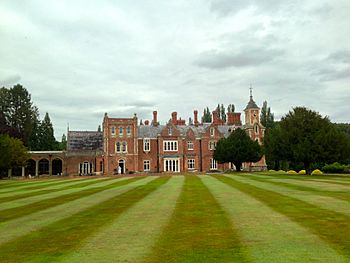The Hendre facts for kids
Quick facts for kids The Hendre |
|
|---|---|

"a striking Victorian country-house, the eclecticism of its architectur(e) reflecting its complex history"
|
|
| Type | House |
| Location | Llangattock-Vibon-Avel, Monmouthshire, Wales |
| Built | 18th and 19th centuries |
| Architect | George Vaughan Maddox, Thomas Henry Wyatt, Aston Webb |
| Architectural style(s) | Victorian Gothic |
| Governing body | golf club |
|
Listed Building – Grade II*
|
|
| Official name: The Hendre | |
| Designated | 11 April 1985 |
| Reference no. | 2773 |
|
Listed Building – Grade II
|
|
| Official name: Garden pond with fountain in former rose garden at The Hendre | |
| Designated | 19 March 2001 |
| Reference no. | 25061 |
|
Listed Building – Grade II
|
|
| Official name: Ornamental bridge in the grounds of The Hendre | |
| Designated | 19 March 2001 |
| Reference no. | 25058 |
|
Listed Building – Grade II
|
|
| Official name: Garden pavilion, raised terrace and screen wall to former rose garden to east and south of The Hendre | |
| Designated | 19 March 2001 |
| Reference no. | 25028 |
| Official name: The Hendre | |
| Designated | 1 February 2022 |
| Reference no. | PGW(Gt)17(Mon) |
| Listing | Grade II* |
| Lua error in Module:Location_map at line 420: attempt to index field 'wikibase' (a nil value). | |
The Hendre (which means "old home" or "farmer's winter residence" in Welsh) is a large, historic country house in Rockfield, Wales. It is the only full-sized Victorian country house in the county of Monmouthshire.
This grand estate belonged to the Rolls family for many years. It was the childhood home of Charles Rolls, who was a pioneer in cars and aviation. He also helped start the famous company, Rolls-Royce.
The house was built in the Victorian Gothic style. Over time, three important architects helped expand it: George Vaughan Maddox, Thomas Henry Wyatt, and Sir Aston Webb. The Hendre is located in Llangattock-Vibon-Avel, about 4 miles (6.4 km) north-west of Monmouth.
It started as a small hunting lodge in the 1700s. The Rolls family greatly expanded it in the 1800s. Today, The Hendre is a Grade II* listed building, meaning it's very important historically. It now serves as the clubhouse for the Rolls of Monmouth Golf Club.
Contents
What Does 'Hendre' Mean?
The name Hendre comes from two Welsh words: hen (meaning "old") and dre (meaning "farmstead").
This name shows an old Welsh tradition. People used to have two homes. One was in the valley for winter, called a hendre. The other was in the uplands for summer, called a hafod (haf means "summer").
The Rolls Family and Their Legacy
The Rolls family became very wealthy and important through marriage. This wealth helped them develop The Hendre into the grand Victorian country house it is today.
The family's story at The Hendre began when Sarah Coysh, who inherited a lot of land and property, married John Rolls (1735–1801). He became the Sheriff of Monmouthshire in 1794.
Their son, also named John Rolls (1776–1837), continued to own the estate. His son, John Etherington Welch Rolls (1807–70), also served as Sheriff of Monmouthshire.
The most famous member of the family was John Allan Rolls (1837–1912). He was a Member of Parliament for Monmouthshire and was later given the title Baron Llangattock in 1892. This made the family, and The Hendre, very important in society.
In 1900, the Duke and Duchess of York (who later became King George V and Queen Mary) even stayed at The Hendre. Charles Rolls, John Allan's son, took the royal couple for rides in his motor car. This was likely their first time in a car!
Charles Rolls: Pioneer of Cars and Flight
Of John Allan Rolls's four children, Charles Rolls was the most well-known. He helped create the famous Rolls-Royce company. Charles was also very interested in flying. He loved hot air balloons and even flew from Monmouth in 1909.
Sadly, in July 1910, Charles Rolls died in an airplane crash near Bournemouth. He was the first British person to die in a powered aircraft accident.
After Lord Llangattock died in 1912, his oldest son, John Maclean Rolls, became the 2nd Baron Llangattock. He died in 1916 from injuries during World War I. Since none of Lord Llangattock's sons had children, the direct family line ended.
The estate eventually passed to a distant cousin, John Charles Etherington Harding. He changed his name to Harding-Rolls to keep the family name connected to the estate. The Harding-Rolls family lived at The Hendre until 1984, when it was sold.
The Mansion's Story
The Hendre started as a small hunting lodge for John Rolls (1776–1837). Over the next 100 years, the Rolls family greatly expanded it.
The first major expansion began in 1830 with architect George Vaughan Maddox. He rebuilt parts of the south wing. John Etherington Welch Rolls continued the work, hiring Thomas Henry Wyatt. Wyatt added the great hall and improved the park between 1837 and 1858.
In 1872, John Allan Rolls (who became Lord Llangattock) started new developments. He removed old stables and built the current Coach House. He also added the Billiard Room, Smoking Room, and Dining Room. Later, Sir Aston Webb added the beautiful Cedar Library.
After World War II, a private boys' boarding school called Ardmore School was briefly at The Hendre. It closed in 1949.
Inside and Out: The Hendre's Design
In 1891, Kelly's Directory described The Hendre as "a handsome mansion of brick and stone, in the Norman and Tudor styles."
The house is made of red brick with special Bath stone details. Above the entrance, there's a carved motto: "Open House Open Heart." The building has many detailed, old-fashioned decorations, like gargoyles.
The front of the house has two floors and seven sections. The dining room section shows how much John Allan Rolls wanted to make the house grander. The wing added by Sir Aston Webb in 1896, including the Cedar Library, shows the house at its most impressive.
Inside, the rooms show how the family's wealth grew. There are small, highly decorated rooms from the 1820s, the large Great Hall from 1858, and the grand dining room and Cedar Library from the late Victorian era. The Cedar Library is famous for its beautiful cedar wood panels and ceiling.
Even though it looked old-fashioned, The Hendre was very modern for its time. It had its own gas and electricity generators. In 1881, John Allan Rolls installed a Gower Bell telephone, making The Hendre the first house in Monmouthshire to have a telephone!
The house is a Grade II* listed building, which means it's a very important historic site.
Exploring The Hendre's Gardens
The Hendre's gardens were once considered the most important Victorian park and garden in Monmouthshire. Even though much of the park is now a golf course, the gardens still show amazing design from the late 1800s.
The estate has an arboretum, which is a collection of different kinds of trees, including very old oak trees. There's also a beautiful lake with a man-made waterfall. Three long driveways lead to the house, with the most impressive one designed by Henry Ernest Milner in the 1890s.
In its best days, the gardens also had formal sunken gardens with fountains, small buildings, a boathouse, and flowerbeds arranged in patterns. The walled kitchen garden is one of the best preserved in Wales, with two original greenhouses still in good condition.
An article from 1903 described the park as "finely wooded" and covering a thousand acres. It mentioned the long, winding drive through forests of conifers and oak trees, where herds of deer roamed.
Many parts of the gardens are also listed as Grade II historic buildings, including the granary, stable block, rose garden pavilion, bridge, and the Box Bush lodge at the park entrance. The Swiss Cottage, another lodge designed by Aston Webb, is even a Grade II* listed building.
Gallery
-
The Great Hall of the Hendre with hammerbeam roof created between 1837-1841
-
Close up view of the clock tower, restored to working order by Rolls-Royce Limited










